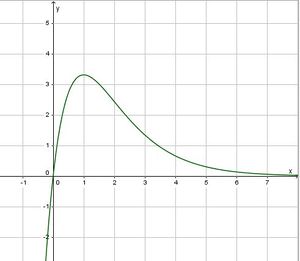M11 Aufgaben zu Logarithmus- und Exponentialfunktionen: Unterschied zwischen den Versionen
| Zeile 101: | Zeile 101: | ||
[[Datei:152-12b.jpg|350px]]<br> | [[Datei:152-12b.jpg|350px]]<br> | ||
und man sieht, dass s' bei a = ln(3) eine VZW +/- hat, also hat s bei a = ln(3) ein Maximum. }} | und man sieht, dass s' bei a = ln(3) eine VZW +/- hat, also hat s bei a = ln(3) ein Maximum. }} | ||
| + | |||
| + | Buch S. 154 / 18 | ||
| + | |||
| + | {{Lösung versteckt|1=<math>f: x \rightarrow 9x\cdot e^{-x}</math> mit D = R.<br> | ||
| + | a) f(0) = 9\cdot 0 \cdot e<sup>0</sup> = 0, also ist (0;0) ein Punkt von G<sub>f</sub>.<br> | ||
| + | b) Es ist <math>9x\cdot e^{-x}=9\cdot \frac{x}{e^x}</math> und nach dem Grenzwert in der [http://www.isb.bayern.de/download/13107/merkhilfe_fuer_das_fach_mathematik_standard.pdf Merkhilfe] für r = 1 ist <math>\lim_{x\to \infty}f(x)=\lim_{x\to \infty}9x\cdot e^{-x}=\lim_{x\to\infty} 9\cdot \frac{x}{e^x}=0</math> | ||
| + | |||
| + | Für den Grenzwert <math>x \to -\infty</math> ist <math>\lim_{x\to -\infty}f(x) =\ </math>" <math>9\cdot(-\infty) \cdot \infty</math> "<math>= -\infty</math> | ||
| + | |||
| + | c) Es ist <math>f'(x)=9e^{-x}+9x\cdot e^{-x}\cdot(-1)=9e^{-x}(1-x)</math><br> | ||
| + | Da stets <math>e^{-x} > 0</math> ist, ist <math>f'(x)=0</math> für 1 - x = 0 und x = 1. <br> | ||
| + | Da y = 1 - x eine fallende Gerade mit Nullstelle x = 1 ist, ist dort der VZW +/- und damit ist bei x = 0 ein Maximum, G<sub>f</sub> hat in (1;<math>\frac{9}{e}</math>) einen Hochpunkt. | ||
| + | |||
| + | d)<br> | ||
| + | [[Datei:154-18.jpg|300px]] | ||
| + | |||
| + | e) Das Bild zu dieser Aufgabe schaut so aus:<br> | ||
| + | [[Datei:154-18e.jpg|300px]]<br> | ||
| + | Aufstellen der Gleichung der Tangente:<br> | ||
| + | <math>f(2) = 18\cdot e^{-2} = \frac{18}{e^2}\approx 2,436</math>. <br> | ||
| + | <math>f'(2)=9e^{-2}(1-2)=\frac{-9}{e^2}\approx 1,218</math>. <br> | ||
| + | Ansatz: <math> y = mx + t</math> mit <math>m = \frac{-9}{e^2}</math> und <math>P(2;\frac{18}{e^2}</math> erhält man<br> | ||
| + | <math> \frac{18}{e^2} = \frac{-9}{e^2}\cdot 2 + t </math><br> | ||
| + | <math> t = \frac{36}{e^2} \approx 4,872</math><br> | ||
| + | Die Gleichung der Tangente t ist <math> y=\frac{-9}{e^2}x + \frac{36}{e^2}</math>. | ||
| + | |||
| + | Der Schnittpunkt mit der y-Achse ist <math>(0;\frac{36}{e^2}</math>), der Schnittpunkt mit der x-Achse ist (4;0) | ||
| + | |||
| + | Der Flächeninhalt <math>a_1</math> des Dreiecks TIP ist <math>A_1=\frac{1}{2}\cdot 2 \cdot (\frac{36}{e^2} - \frac{18}{e^2})\approx 2,436</math><br> | ||
| + | Der Flächeninhalt <math>A</math> des Dreiecks OST ist <math>A=\frac{1}{2}\cdot 4\cdot \frac{36}{e^2}\approx 9,744</math><br> | ||
| + | Das Flächenverhältnis ist <math>\frac{A_1}{A}=\frac{1}{4}</math>, also nimmt die Fläche des Dreicks TIP 25% der Fläche des Dreiecks OST ein.<br> | ||
| + | Diese Aufgabe hätte man auch leichter mit dem Strahlensatz lösen können. Die "kleine waagrechte Strecke" [IP] hat die Länge 2, die "große waagrechte Strecke" [OS] hat die Länge 4. Daher ist der Faktor 2 und für das Verhältnis "Fläche kleines Dreieck" : "Fläche großes Dreieck" = 1 : 2<sup>2</sup> = 1 : 4. Damit hat man das gleiche Ergebnis. | ||
| + | |||
| + | f) Die Situation schaut so aus:<br> | ||
| + | [[Datei:154-18f.jpg|300px]]<br> | ||
| + | Der Flächeninhalt des Dreiecks OLA ist <math>A(s) = \frac{1}{2}\cdot s \cdot f(s) = \frac{1}{2}\cdot s \cdot 9se^{-s}=\frac{9}{2}\cdot s^2\cdot e^{-s}</math><br> | ||
| + | <math>A'(s) = \frac{9}{2}[2se^{-s}+s^2e^{-s}(-1)]=\frac{9}{2}e^{-s}s(2-s)</math> }} | ||
Version vom 16. April 2021, 14:21 Uhr
Buch S. 151 / 4
151 / 4 Da man nur eine Stammfunktion angeben soll, wird auf + C verzichtet.
a) F(x) = ex + x
b) F(x) = - e-x
c) F(x) = 0,5(ex - e-x)
d) F(x) = 0,5x2 + 2x + ex+2
e) F(x) = e1+x
f) F(x) = 2e0,5x
Buch S. 152 / 7a
Es ist P(0;1), Q(2;e2), f'(x) = ex imd f'(0) = 1 und f'(2) = e2.
Gleichung der Tangente t1 in P: y = x + 1
Gleichung der Tangente t2 in Q: y = e2·x - e2. (t erhält man aus der Gleichung e2 = e2·2 - t.)
Den Schnittwinkel der beiden Tangenten erhält man, indem man  bildet, wenn
bildet, wenn  der Schnittwinkel von t1 mit der Waagrechten im Schnittpunkt und
der Schnittwinkel von t1 mit der Waagrechten im Schnittpunkt und  der Schnittwinkel von t2 mit der Waagrechten im Schnittpunkt ist.
der Schnittwinkel von t2 mit der Waagrechten im Schnittpunkt ist.
Es ist  , also ist
, also ist  .
.
Es ist  , also ist
, also ist 
Damit ist  .
.
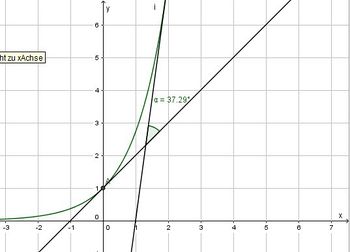
 ergibt
ergibt  .
.Buch S. 152 / 8

a) Die Koordinaten des Schnittpunkts S der beiden Graphen erhält man, indem man die Funktionsterme gleich setzt.









 , also S(-0,2; 1,11) (näherungsweise, aber genügend genau!)
, also S(-0,2; 1,11) (näherungsweise, aber genügend genau!)
Den Schnittwinkel zwischen beiden Graphen erhält man, indem man den Schnittwinkel der Tangenten in S an Gf und Gg bestimmt. Dazu muss man nicht die Tangetengleichungen aufstellen. Es reicht, wenn man die Steigungen in S kennt, denn es ist  .
.
Man berechnet  und
und  .
.
 und
und  .
.
Für  ist
ist  und
und  und
und
für  ist
ist  und
und  .
.
Damit ist  .
.

b) Die Tangente in A soll parallel zu einer Geraden h mit Steigung - 0,5 sein. Also ist f'(xA) = - 0,5.


 ergibt
ergibt  und
und  .
.
A(0;1) 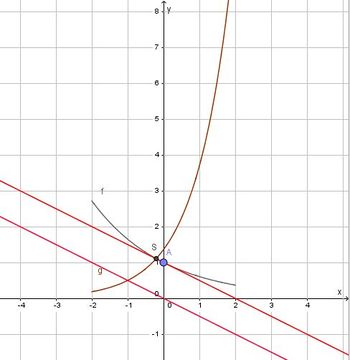
Die Tangente in B soll senkrecht zu einer Geraden k mit Steigung -2 sein. Die Tangente in B an Gg hat dann die Steigung 0,5. Also ist g'(xB) = 0,5.


 ergibt
ergibt 

Buch S. 153 / 14
Graph 1 gehört zu Funktion f (f ist die einzige Funktion mit D = R+. Außerdem kann man den Funktionsterm vereinfachen. Es ist f(x) = 2xeln(x)=2x2 und der Graph ist eine halbe Parabel.)
Graph 2 gehört zu Funktion d (d hat bei x = 0 eine Polstelle. )
Graph 3 gehört zu Funktion a (ex wird um den Faktor 2 in y-Richtung gestreckt, ebenso in x-Richtung, also ist der Verlauf fast wie bei der "e-Funktion" durch (0;2).)
Graph 4 gehört zu Funktion b (-ex ist ex an der x-Achse gespiegelt und wird um 3 nach oben verschoben.)
Graph 5 gehört zu Funktion c (c ist die einzig verbleibende Funktion mit c(0) = 2.)
Buch S. 152 / 9
Zuerst zeichnet man den Sachverhalt.
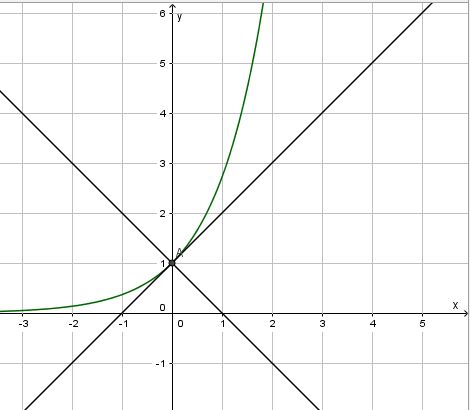
Es ist f'(0) = 1, also ist die Steigung m = 1 der Tangente in (P0;1). Die Tangente hat dann die Gleichung y = x + 1. Sie schneidet die x-Achse in A(-1;0).
Die Normale zur Tangente in P hat dann die Steigung m = -1 und sie hat die Gleichung y = -x +1. Sie schneidet die x-Achse in B(1;0).
Buch S. 152 / 12
a) Die Koordinaten des Schnittpunkts B liest man gleich aus dem Diagramm ab, da beide Graphen sich bei x = 0 schneiden. Es ist B(0;1).
Die x-Koordinate von A erhält man durch Lösen der Gleichung  .
.



Substituiert man  , dann man hat die quadratische Gleilchung
, dann man hat die quadratische Gleilchung  zu lösen. Es ist
zu lösen. Es ist  und daher hat die Gleichung
und daher hat die Gleichung  die zwei Lösungen
die zwei Lösungen  . Die Lösung
. Die Lösung  führt beim Resubstituieren auf
führt beim Resubstituieren auf  , also
, also  . (Lösung für B!)
. (Lösung für B!)
Die zweite Lösung  führt beim Resubstituieren auf
führt beim Resubstituieren auf  und
und  . Also ist A(ln9; 3).
. Also ist A(ln9; 3).
b) Es ist S(a; e0,5a) und T(a;4-3e-0,5a) und die Länge der Strecke [ST] ist  (T liegt über S, also ist bei yT - yS die Differenz positiv).
(T liegt über S, also ist bei yT - yS die Differenz positiv).
Betrachtet man nun die Funktion  für
für ![a \in [0;ln(9)]](/images/math/6/8/3/683526e7906cfa2c08a68415cb17f301.png) , dann muss man das Maximum von s finden. Dazu setzt man die
, dann muss man das Maximum von s finden. Dazu setzt man die  gleich 0 und erhält bei VZW +/- das gesuchte a.
gleich 0 und erhält bei VZW +/- das gesuchte a.






Lässt man sich mit GeoGebra die Graphen von s und s' zeichnen, dann hat man dieses Bild:
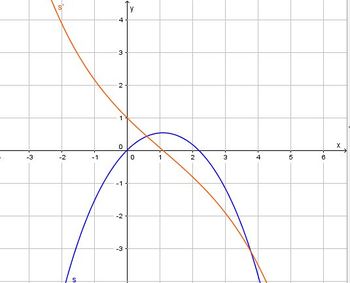
Buch S. 154 / 18
 mit D = R.
mit D = R.
a) f(0) = 9\cdot 0 \cdot e0 = 0, also ist (0;0) ein Punkt von Gf.
b) Es ist  und nach dem Grenzwert in der Merkhilfe für r = 1 ist
und nach dem Grenzwert in der Merkhilfe für r = 1 ist 
Für den Grenzwert  ist
ist  "
"  "
"
c) Es ist 
Da stets  ist, ist
ist, ist  für 1 - x = 0 und x = 1.
für 1 - x = 0 und x = 1.
Da y = 1 - x eine fallende Gerade mit Nullstelle x = 1 ist, ist dort der VZW +/- und damit ist bei x = 0 ein Maximum, Gf hat in (1; ) einen Hochpunkt.
) einen Hochpunkt.
e) Das Bild zu dieser Aufgabe schaut so aus:
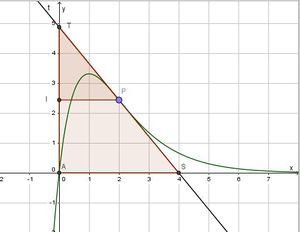
Aufstellen der Gleichung der Tangente:
 .
.
 .
.
Ansatz:  mit
mit  und
und  erhält man
erhält man


Die Gleichung der Tangente t ist  .
.
Der Schnittpunkt mit der y-Achse ist  ), der Schnittpunkt mit der x-Achse ist (4;0)
), der Schnittpunkt mit der x-Achse ist (4;0)
Der Flächeninhalt  des Dreiecks TIP ist
des Dreiecks TIP ist 
Der Flächeninhalt  des Dreiecks OST ist
des Dreiecks OST ist 
Das Flächenverhältnis ist  , also nimmt die Fläche des Dreicks TIP 25% der Fläche des Dreiecks OST ein.
, also nimmt die Fläche des Dreicks TIP 25% der Fläche des Dreiecks OST ein.
Diese Aufgabe hätte man auch leichter mit dem Strahlensatz lösen können. Die "kleine waagrechte Strecke" [IP] hat die Länge 2, die "große waagrechte Strecke" [OS] hat die Länge 4. Daher ist der Faktor 2 und für das Verhältnis "Fläche kleines Dreieck" : "Fläche großes Dreieck" = 1 : 22 = 1 : 4. Damit hat man das gleiche Ergebnis.
f) Die Situation schaut so aus:
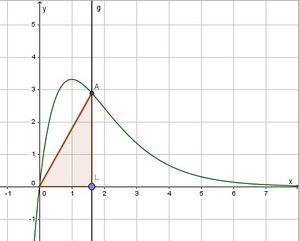
Der Flächeninhalt des Dreiecks OLA ist 
![A'(s) = \frac{9}{2}[2se^{-s}+s^2e^{-s}(-1)]=\frac{9}{2}e^{-s}s(2-s)](/images/math/a/e/8/ae86fa5ca668086e103dc7c83ff73d63.png)
